Masterpiece Story: Monet’s Garden at Giverny
Claude Monet loved gardening almost as much as he loved painting. When he finally settled in Giverny, he created a natural masterpiece which acted as...
Catriona Miller 23 November 2025
Jean-Henri Riesener’s Bureau du Roi is a masterpiece of 18th-century French art. It was and still is a designer piece fit for a king.
Jean-Henri Riesener (1734–1806) was one of the leading furniture makers of the late 18th century in France. He was the favorite cabinetmaker of Queen Marie Antoinette and became the Ébéniste Ordinaire du Roi (king’s cabinetmaker) in 1774. He officially dominated French furniture styles for a decade (1774–1784), but his artistic influence began as early as 1763, when he oversaw the creation of his first court-commissioned piece, the Bureau du Roi.
Riesener knew he had a major commission and painstakingly took six more years to finish what his teacher, Jean-François Oeben, had already spent three years working on before his death. Therefore, Bureau du Roi consumed nine years of combined talent and effort. However, the investment paid dividends because the Bureau du Roi was instantly hailed as a masterpiece of 18th-century French decorative arts. It was, and still is, a design piece fit for a king.
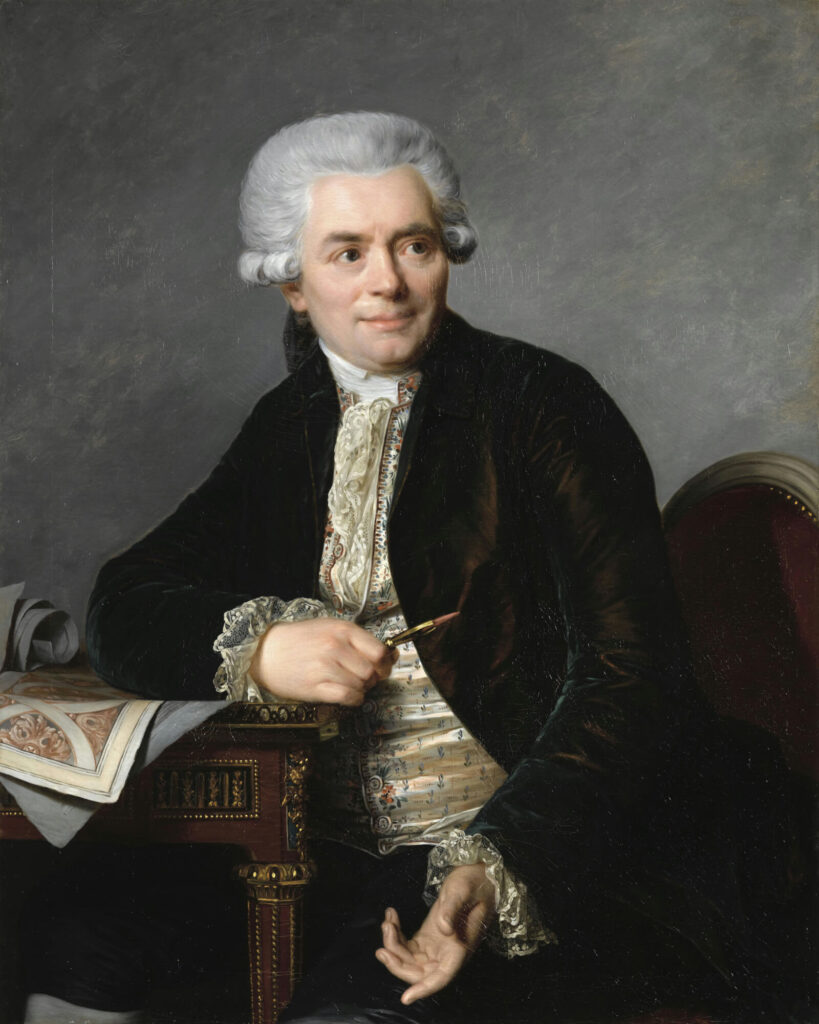
Antoine Vestier, Portrait of Jean-Henri Riesener, 1786, Palace of Versailles, Versailles, France.
Bureau du Roi is a large and substantial piece of furniture. It is made from 2,800 assembled pieces including 509 pieces of solid wood (over 5mm, 3/16 in. thick) in oak, lime, amaranth, and rosewood. It features 1,550 pieces of veneer in amaranth, rosewood, boxwood, blackened pear wood, and maple, and 645 pieces of brass and iron that form the decorative mountings and internal hardware mechanisms.
Inside, it has 96 pieces of fabric lining including velvet and moiré silk. Finally, it has two majestic large plaques of blue-and-white Sèvres porcelain mounted on its sides. In both volume and materials, the Bureau du Roi is an impressive and expensive designer piece.
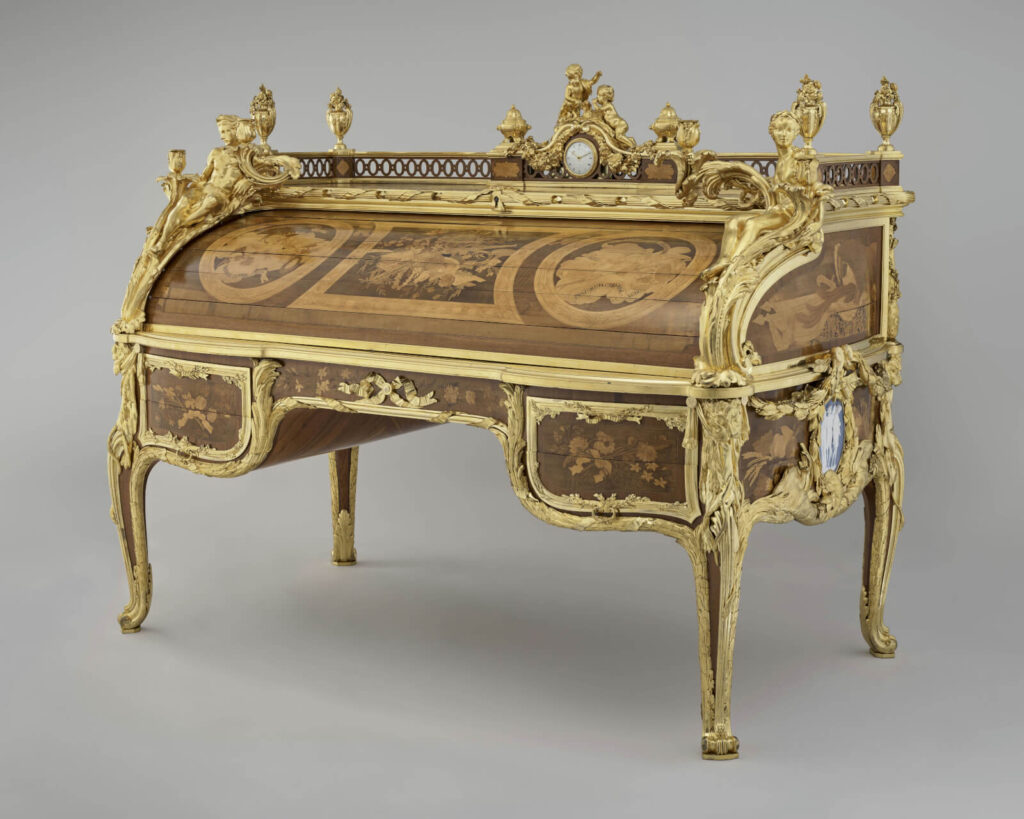
Jean-Henri Riesener, Bureau du Roi, 1760–1769, Palace of Versailles, Versailles, France.
This masterpiece of furniture is known as the Bureau du Roi because it was specifically commissioned by and created for King Louis XV of France. He desired a new desk to store many classified papers and to facilitate the daily writing of personal letters and official documents. The desk was designed to be placed in the king’s private, office (cabinet intérieur du roi) at the famous Château de Versailles.
It remained at the majestic château after Louis XV’s death and was later used by his grandson and successor, King Louis XVI. It was on this desk that Louis XVI signed documents politically approving and financially supporting the American Revolution of independence against France’s rival, the United Kingdom. Later, during the Revolution of 1789, the desk was seized by the new government and sold at auction to foreign buyers. The desk remained in private collections until its state-funded purchase in 1957, when it was returned to its original home.

Jean-Henri Riesener, Bureau du Roi, 1760–1769, Palace of Versailles, Versailles, France.
Bureau du Roi is a roll-top desk. Therefore, the curved front panel slides along a hidden track to reveal the desk’s interior. Riesener originally created the desk to open with a key inserted into the top central lock. A single twist of the key would activate a hidden spring mechanism that would slowly but smoothly lift the entire front paneling. Sadly, this spring mechanism was broken at some point in the desk’s history and surviving records do not explain how the spring mechanism worked. Therefore, a recent restoration still allows the key to activate the front panelling to open but with a turning crank-style motion as if winding a clock. The modern alteration is still impressive but not as graceful as the original one-twist experience.
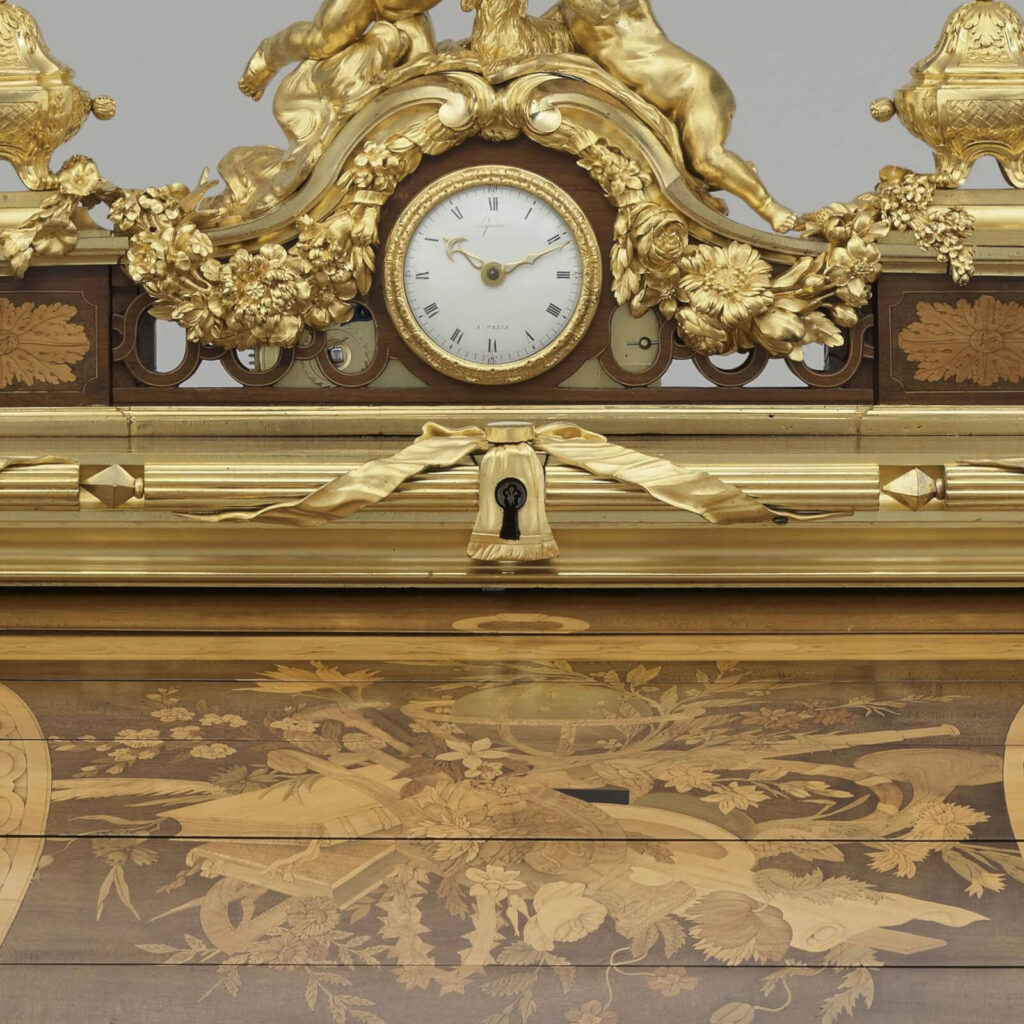
Jean-Henri Riesener, Bureau du Roi, 1760–1769, Palace of Versailles, Versailles, France. Detail.
The Bureau du Roi is comparable to a modern filing cabinet, with its many storage areas and divisions. The desk has four external drawers facing the front panel. They are beautifully framed with bronze mountings. The four drawers are arranged in two vertical pairs.
Once the Bureau du Roi is opened, there are many divisions inside, including drawers, racks, and secret compartments. There are six internal drawers arranged in two sets of three. The two sets of drawers flank the left and right side of three sliding racks in the center.
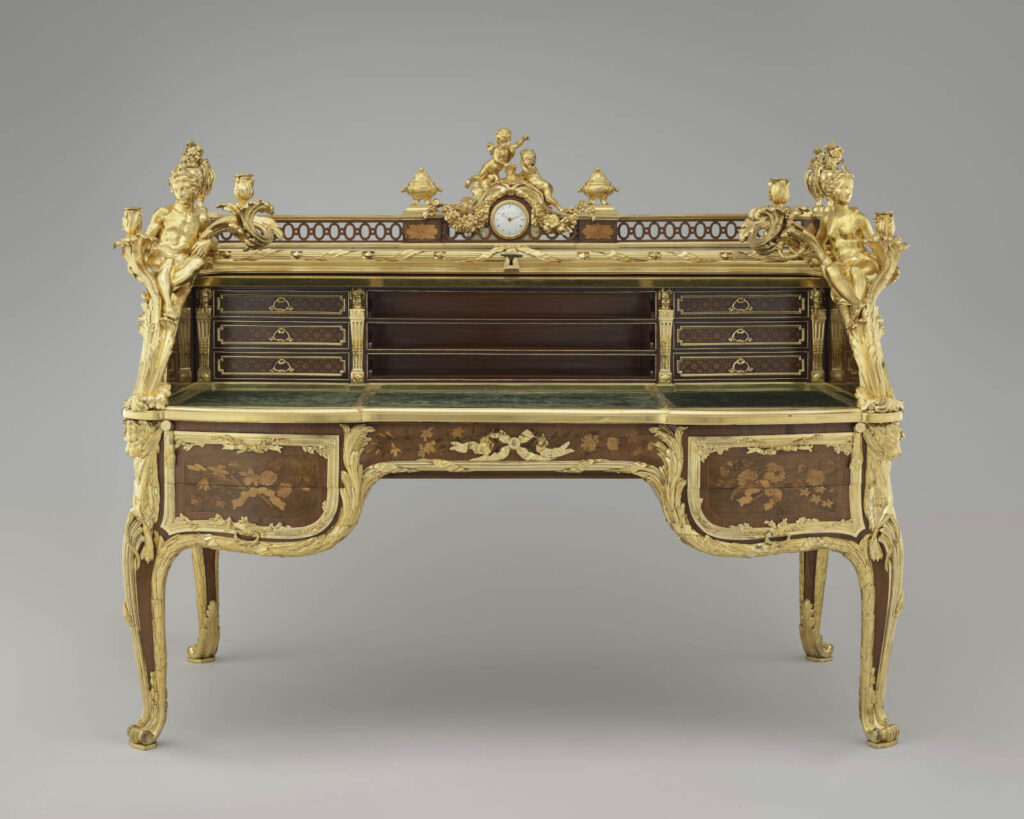
Jean-Henri Riesener, Bureau du Roi, 1760–1769, Palace of Versailles, Versailles, France.
The handles of the internal drawers are worth noting. At first, they appear as an abstract scrolling motif. However, they are in fact two cursive capital “L” letters, one normal and one reversed. The “L” of course being the first initial of “Louis” for King Louis XV. Hence, personalization is integral to this desk designer piece.

Jean-Henri Riesener, Bureau du Roi, 1760–1769, Palace of Versailles, Versailles, France. Detail.
The writing pad of the desk is covered in beautiful green Moroccan leather. Then and now, a leather writing pad provides a cushioned yet firm writing surface to promote a smooth calligraphy. The writing pad also tilts up and forward to convert into an inclined reading rest for books and large documents.
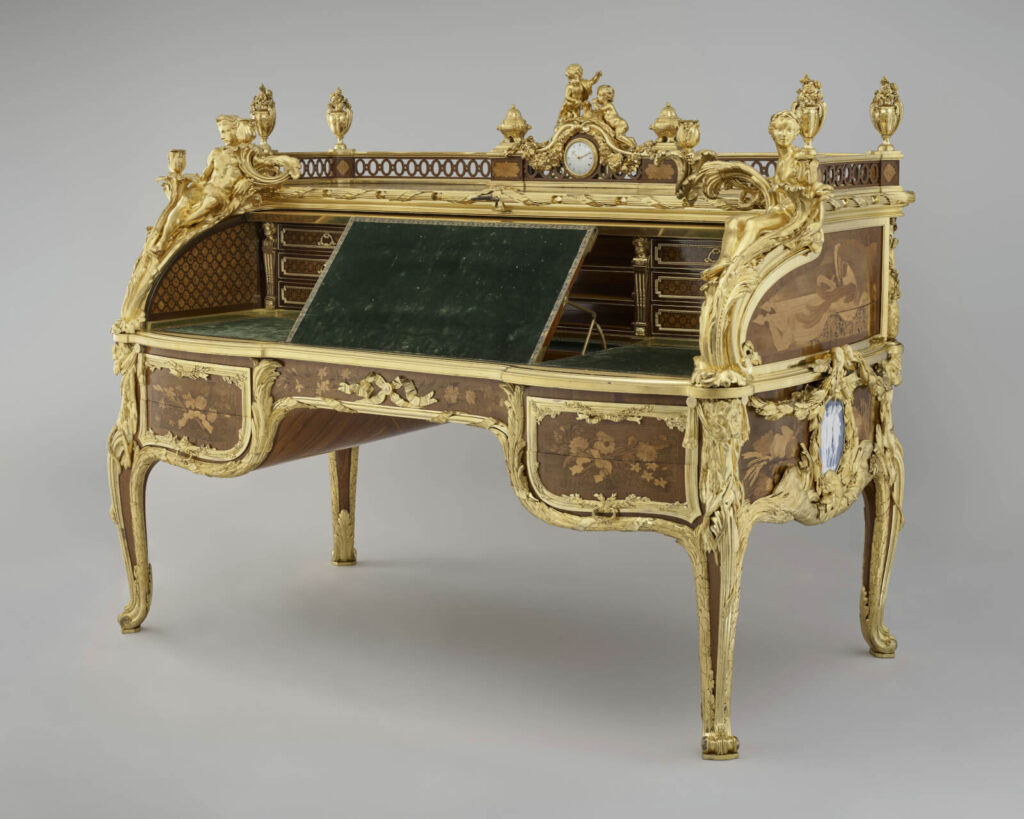
Jean-Henri Riesener, Bureau du Roi, 1760–1769, Palace of Versailles, Versailles, France.
The pad is also hinged at the back so it lifts upward to reveal a hidden secret cavity below. Inside the cavity are three secret drawers. These drawers once held the king’s most private personal letters and official classified documents.
What is even more surprising is that the desk has two additional secret compartments on the exterior left and right sides. With the press of an internal button, the compartments open to reveal the most private items. Perhaps even love letters since Louis XV was known to be a very gallant and amorous gentleman towards beautiful ladies.
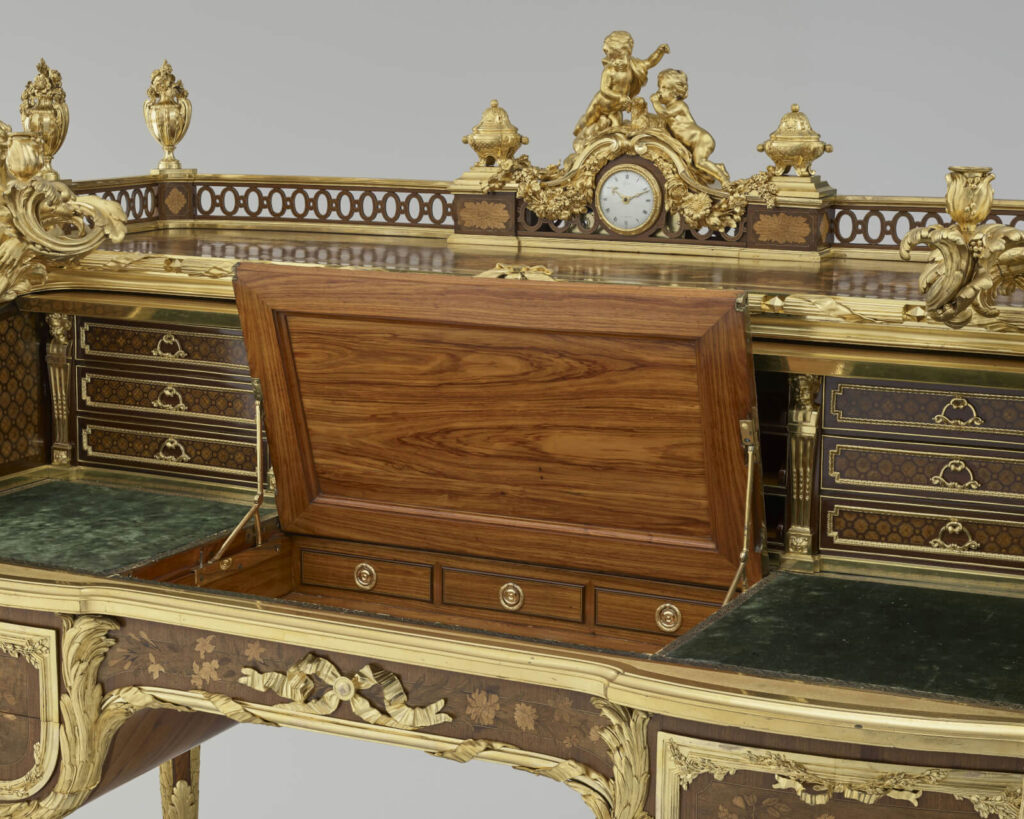
Jean-Henri Riesener, Bureau du Roi, 1760–1769, Palace of Versailles, Versailles, France. Detail.
The desk was an outrageously expensive design masterpiece to create. Its entire construction and surface represent the pinnacle of Rococo royal taste. Riesener paid attention to the orientation of wood fibers when cutting and carving to avoid cracking and splintering. This allowed a consistently refined wood production that was further enhanced by a profusion of gilt-bronze mountings.
The surface of the desk is covered in marquetry patterns representing flowers and objects representing war, navy, astronomy, mathematics, writing, lyric poetry, and dramatic poetry.
Moving to the ride side of the desk, the side view reveals a beautiful blue-and-white Sèvres porcelain panel mounted in gilt-bronze. It presents three Neoclassical figures. Cupid is in the center flanked by two women. Without obvious attributes, their identities are difficult to guess, but one is possibly Psyche, the famous lover of Cupid.
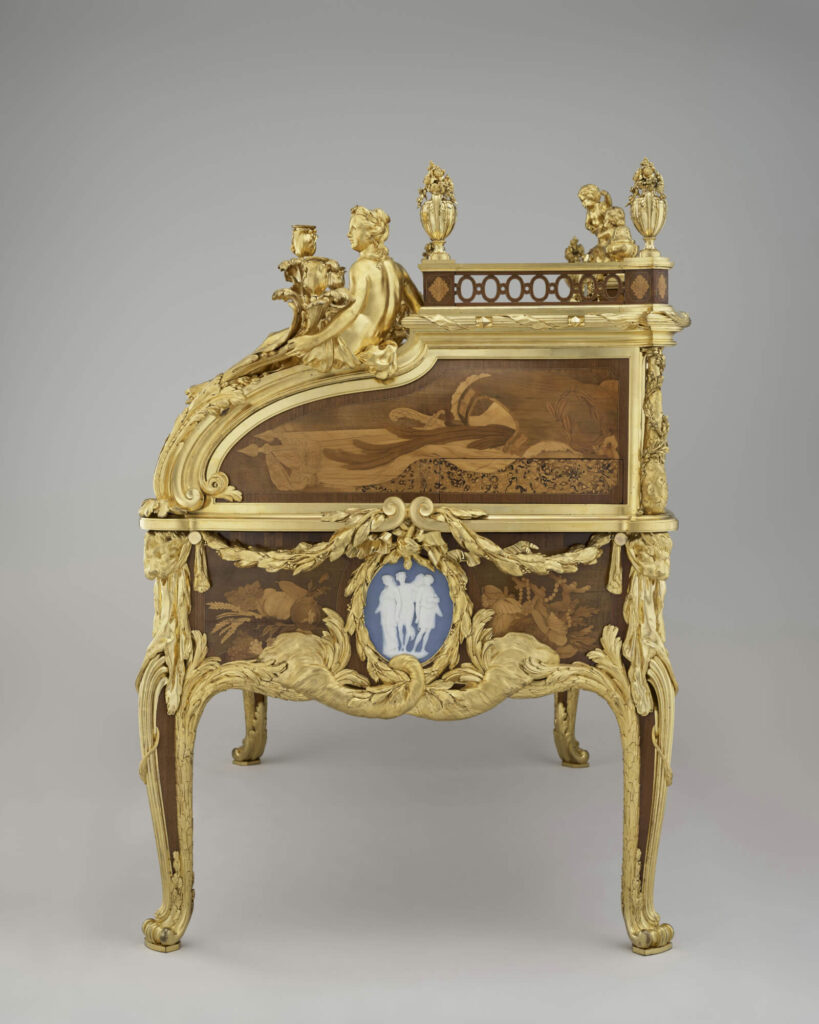
Jean-Henri Riesener, Bureau du Roi, 1760–1769, Palace of Versailles, Versailles, France.
Symbols of war appear above with a sword, a Roman chest plate, and a laurel wreath.
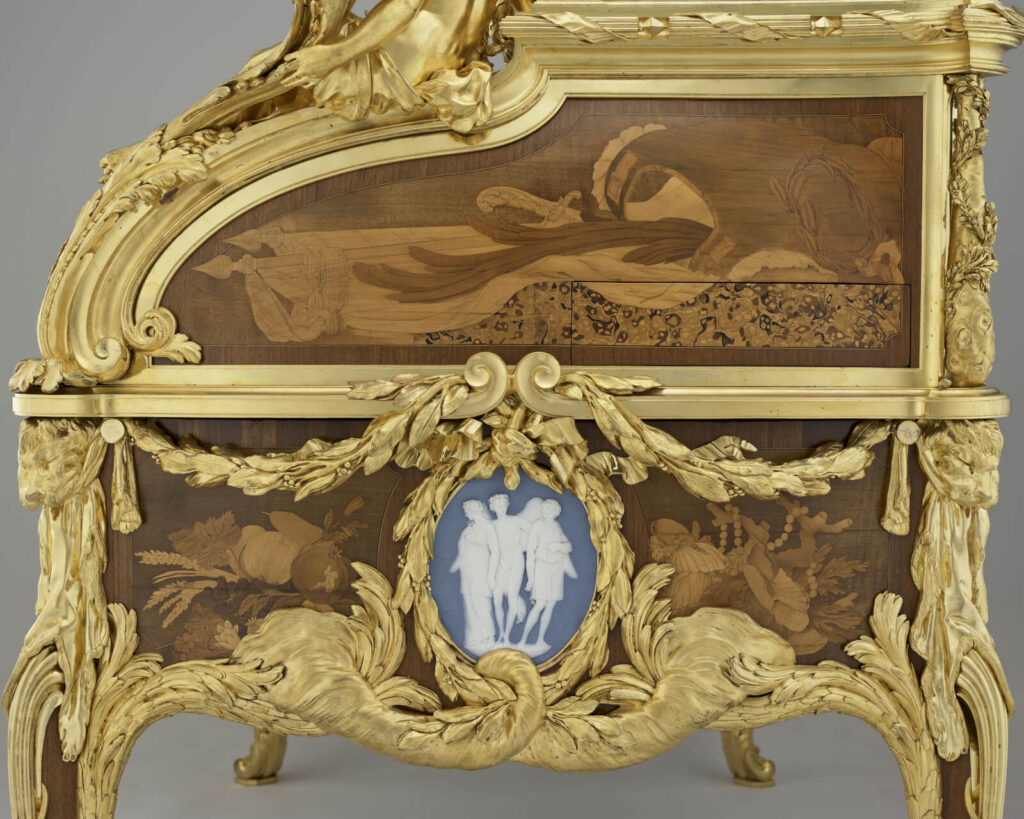
Jean-Henri Riesener, Bureau du Roi, 1760–1769, Palace of Versailles, Versailles, France. Detail.
Turning further around the desk, and facing the back, are additional decorative panels featuring Minerva and symbols of arts and sciences. The most reflective is the gold frieze in the upper center.
Moving further around the desk, to the left side, is another Sèvres porcelain panel matching in style to the right side. However, this porcelain piece has three, easily identifiable figures: the three Graces.
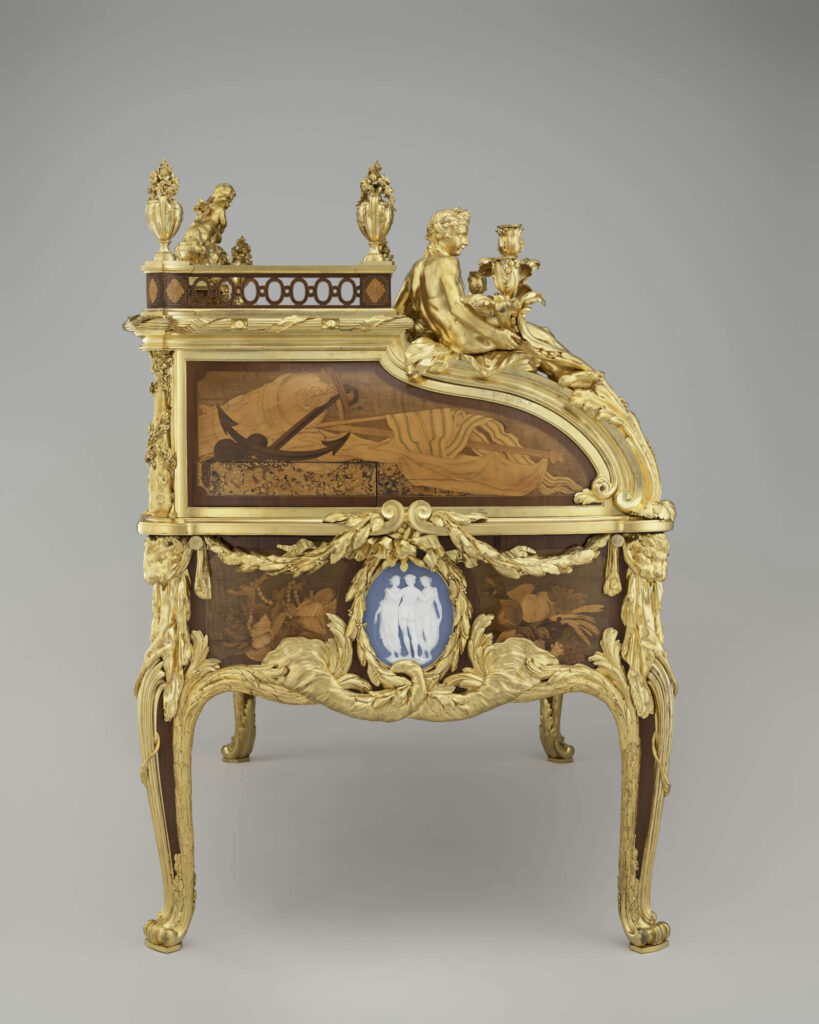
Jean-Henri Riesener, Bureau du Roi, 1760–1769, Palace of Versailles, Versailles, France.
Above the Graces are representations of the navy such as an anchor and a tube map case.
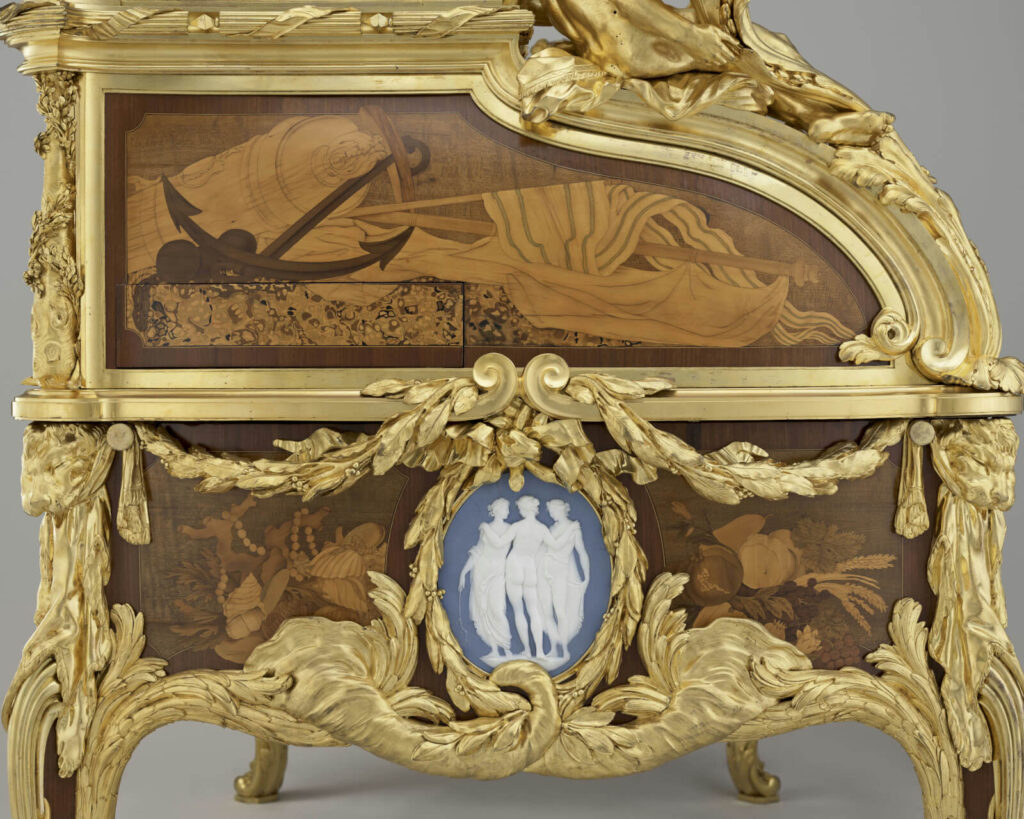
Jean-Henri Riesener, Bureau du Roi, 1760–1769, Palace of Versailles, Versailles, France. Detail.
Returning to the front view, there is a detailed marquetry on the desk’s top surface. The central motif has sheet music, books, and flowers, flanked by floral decorations on the sides.
At the top center of the desk is a magnificent clock. It is double-faced, for easy viewing from both the front and back of the desk. This allows almost anyone in the room to tell the time. The clock face features delicate black Roman numerals, gilt dial hands, and gilt mounting edges for the two clear glass covers. The wooden body is surmounted by gilt-bronze mounts, known as ormolu, of fanciful scrolls, flower garlands, two decorative lidded urns, a dog, and two children.

Jean-Henri Riesener, Bureau du Roi, 1760–1769, Palace of Versailles, Versailles, France. Detail.
Further figural ormolu are found on the front top corners by the sitter’s shoulders. These statue-like adornments are practical candelabras that hold candles for reading. Remember, this is the age before electricity and electrical lighting!
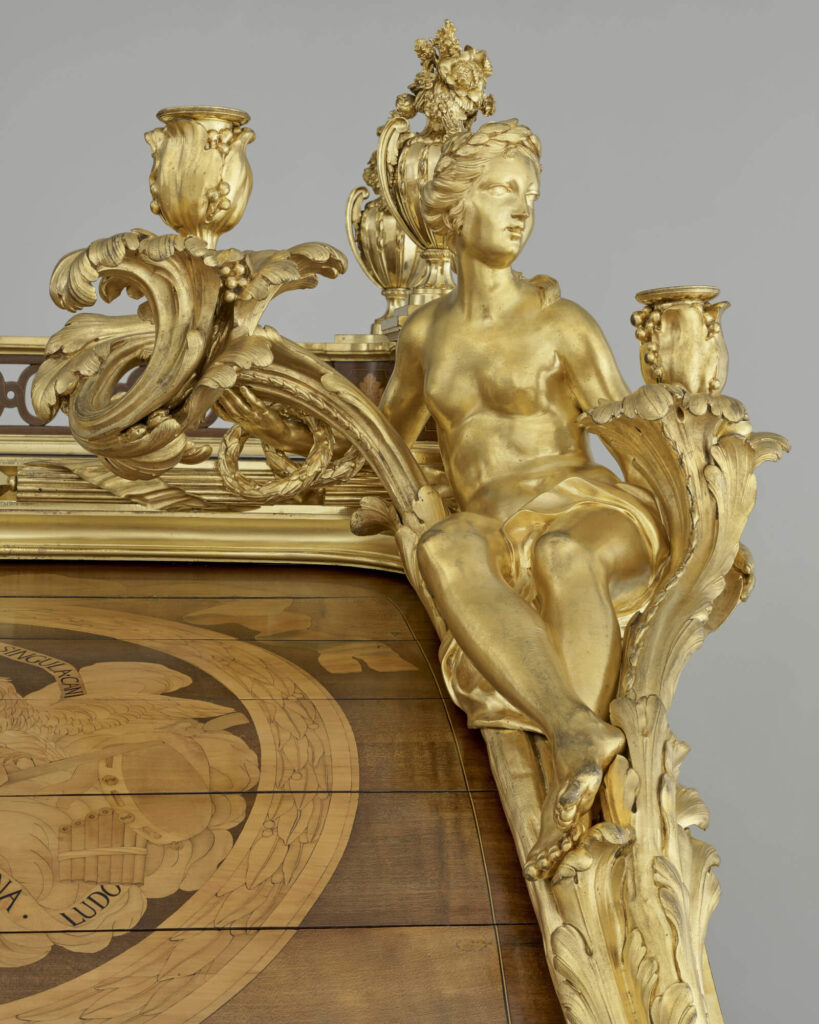
Jean-Henri Riesener, Bureau du Roi, 1760–1769, Palace of Versailles, Versailles, France. Detail.
The desk was the result of a combined efforts of several skilled craftsmen and artists. First, Jean-François Oeben was the teacher who began the initial planning and designs, which Riesener further developed and expanded. Louis-Barthélémy Hervieu was the engraver who worked on the inlaid marquetry. Jean-Claude Duplessis was the bronzesmith who created, installed, and mounted the abundant internal metal mechanisms and exterior decorations. Lastly, Jean-Antoine Lépine was the clockmaker who designed and calculated the intricacies of the small, reliable double-faced timepiece centuries before the invention of batteries.
Therefore, Jean-Henri Riesener cannot be credited as the sole artist of Bureau du Roi. However, he was the chief designer, manager, and artist of the team like the famous painter Peter Paul Rubens with his workshop.
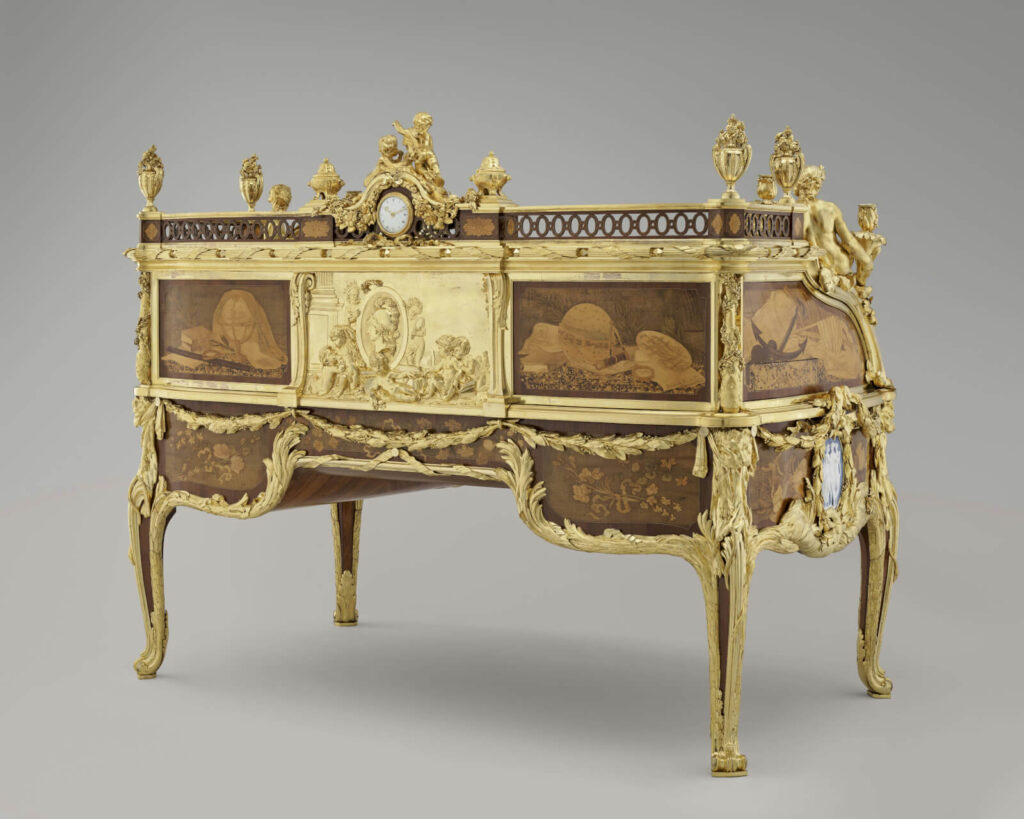
Jean-Henri Riesener, Bureau du Roi, 1760–1769, Palace of Versailles, Versailles, France.
Bureau du Roi miraculously survived centuries of revolution, multiple sales, and an ever-changing aesthetic taste in society. It is shocking to believe that 18th-century French furniture could ever be unwanted and undesirable! However, tastes change and appreciation fluctuates over time, like the crests and troughs of a wave. Thankfully, the crest continues to ride high, and the Bureau du Roi is still appreciated for its magnificence, personalization, and grandeur. Just imagine how many other marvelous designer pieces were lost to the destructive revolutions of 1789, 1830, and 1848. It is miraculous that so much has survived! Societies may rise and fall, but the search and appreciation for beauty is eternal. Let the Bureau du Roi be a testimony to the enduring spirit of human creativity. Art is forever.
Bureau du Roi, Palace of Versailles Online Collection. Retrieved Sep. 15, 2025.
Bureau du Roi, Palace of Versailles YouTube, October 30, 2014.
Ebéniste – Atelier d’art de Versailles, Palace of Versailles YouTube, July 24, 2020.
Jean-Henri Riesener, Palace of Versailles. Retrieved Sep. 15, 2025.
“Marie-Antoinette retrouve son bureau, Versailles se remeuble petit à petit”, Le Point, March 21, 2011.
Restauration du bureau de Louis XV, Palace of Versailles. Retrieved Sep.15, 2025.
DailyArt Magazine needs your support. Every contribution, however big or small, is very valuable for our future. Thanks to it, we will be able to sustain and grow the Magazine. Thank you for your help!